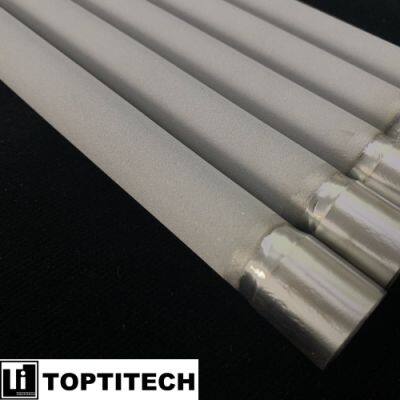Home > Products > Stainless Steel Sintered Production > Sintered stainless steel filters as carbonation stone for beer
Sintered stainless steel filters as carbonation stone for beer
- 100000 Piece / Pieces per Month
- Shanghai or Tianjin
- T/T L/C D/P D/A Credit Card PayPal Cash Escrow
Product Details
| Brand Name: | TOPTITECH | Place of Origin: | China |
Product Description
Sintered stainless steel filters as carbonation stone for beer
TOPTITECH stainless steel carbonation stones, not truly stones, are predominantly crafted from porous stainless steel 316L, also known as 'Air Stones'. These stones are commonly employed to aerate wort before fermentation, ensuring a robust start to the fermentation process. Constructed from top-tier food-grade stainless steel material 316L, TOPTITECH carbonation stones boast healthiness, practicality, durability, high-temperature resistance, and corrosion resistance. They offer easy cleaning and remain intact in beer or wort post-use.
These stainless steel carbonation stones from TOPTITECH are well-suited for force carbonating beer, making them an excellent choice for kegged beer carbonation or as an aeration stone pre-fermentation. Professionals use stainless steel carbonation stones to carbonate beverages such as beer, champagne, or sparkling meads with carbon dioxide. The micron stainless steel carbonating stone accelerates beer carbonation, producing a long-lasting head due to the creation of smaller bubbles. It rapidly infuses beer/soda water with CO2 or O2 by passing the gas through millions of tiny stone pores, effectively dissolving it into the liquid, enriching the mouthfeel of your beer or soda water.
Specification:
Material: stainless steel 316L
Pore size: 1um
External diameter: 20mm
Length: 270mm
Connection: 3/8" thread on both sides
Advantage:
1. Enhancing yeast health: By inserting the oxygenation wand into the fermenter and introducing thousands of minute oxygen bubbles for 1-2 minutes, yeast vitality increases, leading to the production of exceptional flavors and ensuring complete fermentation. Yeast thrives in an environment devoid of bacterial competition, ensuring both quality fermentation and a bacteria-free end product.
2. Enhanced Carbonation Control: Stainless steel filters provide brewers with precise control over the carbonation levels in beer, ensuring consistent quality and desired effervescence.
3. Enhanced Efficiency: Stainless steel filters used as carbonation stones offer enhanced efficiency in the carbonation process compared to traditional methods. The micro-pores in the stainless steel allow for a finer dispersion of carbon dioxide bubbles, resulting in more effective and controlled carbonation.
4. Consistent Carbonation: One of the key benefits of using stainless steel filters as carbonation stones is the ability to achieve consistent carbonation levels in every batch of beer produced. This consistency is crucial for maintaining the desired flavor profile and mouthfeel of the beer.
Working Principle of Stainless Steel Filters as Carbonation Stones:
The working principle of stainless steel filters used as carbonation stones is based on their ability to facilitate the controlled infusion of carbon dioxide (CO2) gas into beer or other carbonated beverages. Here's a detailed breakdown of how these filters operate:
1. Micro-Porous Structure:
Stainless steel filters designed as carbonation stones feature a fine and uniform micro-porous structure. These microscopic pores serve as channels for the passage of carbon dioxide gas from a pressurized source into the liquid.
2. Gas Diffusion:
When the carbonation stone is connected to a gas line carrying CO2, the gas is forced through the tiny pores of the stainless steel filter. The high pressure of the CO2 gas causes it to diffuse out of the pores in a dispersed and controlled manner.
3. Even Dispersion:
The fine pores in the stainless steel filter ensure that the carbon dioxide gas is evenly dispersed throughout the liquid, whether it be beer, cider, or other carbonated beverages. This uniform dispersion is crucial for achieving consistent carbonation levels.
4. Bubble Formation:
As the carbon dioxide gas escapes from the pores of the stainless steel filter, it forms tiny bubbles within the liquid. These bubbles gradually rise to the surface, dissolving into the liquid and creating the desired level of carbonation.
5. Controlled Carbonation:
Brewers can regulate the flow rate of CO2 gas and the duration of exposure to achieve the desired carbonation level in the beverage. By adjusting these parameters, brewers can tailor the carbonation process to meet specific taste preferences and style requirements.
Contact Us

- Baoji Yinggao Metal Materials Co., Ltd.
- Contact nameAna Chat Now
- Phone86-0917-3873009
- AddressWeibin Baoji,Shaanxi
Product Categories
| porous titanium | Titanium Material | Titanium Process parts | Stainless Steel Sintered Production |
| Copper Sintering Material | sintered titanium product | other products |
-
Sintered Rupture Disks
-
Platinum-coated titanium anode
-
5-Layer Sintered Wire Mesh
-
Titanium anode (MMO)
-
5-Layer Sintered Wire Mesh
-
Sintered Wire Mesh
-
Titanium Filter Element
-
Titanium Anode For Water Treatment
-
Sintered Wire Mesh
-
5-Layer Sintered Wire Mesh
-
Titanium anode (MMO)
-
5-Layer Sintered Wire Mesh
Popular Searches
- peco gas filter
- peco filter elements
- vane pack mist eliminator
- eye glass string
- eye glass strings
- lint traps for washing machines
- reticulated polyurethane foam
- foam gutter guard
- Reticulated Filter Foam
- aire filter foam
- clean air spong
- excel filter unique
- fire retardent sponge
- facet filter
- filter foam importers
- bios foam
Recommended Products
- GR1 Titanium Filter Tube for Inline Diffuser
- 50 micron custom threaded SS316L powder sintered filter element
- titanium sintered filters
- sintered porous metal filter
- stainless steel sparger
- 0.45um Double-opened Titanium Powder Porous Filter Pipe
- Hengko 0.1 to 90μ M Sintered Porous Metal Powder 316L Stainless Steel Filter Disc
- Hengko Filter-Max Centering Ring with Sintered Metal Filter DN25 ISO-Kf25 20 Micron Maximum Vacuum Protection
- stainless steel wire wrapped johnson well screen
- water well borewell screen
- water well johnson screen
- GT Air Intake Filter
Find Similar Products By Category
- Mechanical Parts & Fabrication Services > Filter Supplies > Other Filter Supplies



